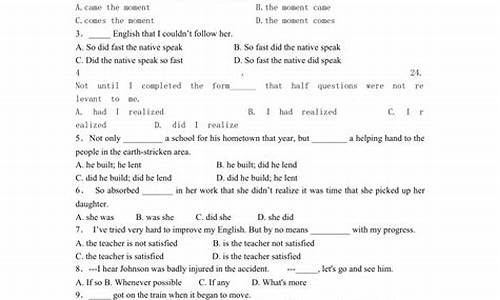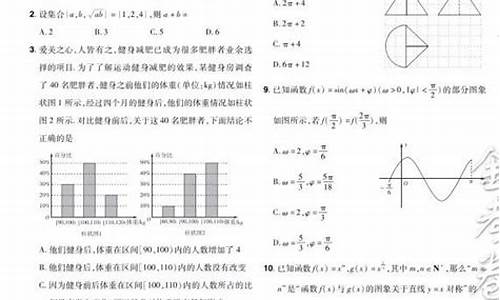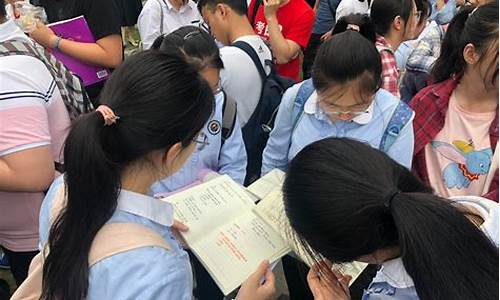您现在的位置是: 首页 > 教育趋势 教育趋势
倒装高考真题-2014高考英语倒装句
tamoadmin 2024-10-31 人已围观
简介1.倒装句和情态动词笔记2.英语语法where倒装句知识点3.谁能给我讲一下英语"倒装句"的相关知识4.求英语倒装句分类及复杂例句!以及三种时态虚拟语气的分别例句!越复杂越好!倒装句和情态动词笔记倒装句一、完全倒装,即将谓语移到主语前。英语中构成完全倒装的情形主要有:1. 以 here, there, now, then, out, in, up, down, off, away 等方向性副词开头
1.倒装句和情态动词笔记
2.英语语法where倒装句知识点
3.谁能给我讲一下英语"倒装句"的相关知识
4.求英语倒装句分类及复杂例句!以及三种时态虚拟语气的分别例句!越复杂越好!
倒装句和情态动词笔记

倒装句
一、完全倒装,即将谓语移到主语前。英语中构成完全倒装的情形主要有:
1. 以 here, there, now, then, out, in, up, down, off, away 等方向性副词开头的句子,且句子主语是名词时,句子用完全倒装。如:
Here comes the bus. 公共汽车来了。
Now comes your turn. 现在该你了。
Then came a new difficulty. 这时又产生了一个新的困难。
The door opened and in came Mr Li. 门开了,李先生进了来。
注:若主语为代词,则不用倒装。如:
The door opened and in she came. 门开了,她走了进来。
2. 将表语和地点状语(多为介词短语)置于句首加以强调时,其后通常用倒装语序。如:
Among them was my friend Jim. 他们当中就有我的朋友吉姆。
Around the lake are some tall tree. 湖的四周有些高树。
注:在表语置于句首的倒装结构中,要注意其中的谓语应与其后的主语保持一致,而不是与位于句首的表语保持一致。
3. 状语或表语位于句首时的倒装
为了保持句子平衡或使上下文衔接紧密,有时可将状语或表语置于句首,句中主语和谓语完全倒装:
Among these people was his friend Jim. 他的朋友吉姆就在这些人当中。
4. 分词和不定式置于句首的倒装
有时为了强调,可将谓语部分的现在分词、过去分词或不定式置于句首,从而构成倒装:
Buried in the sands was an ancient village. 一个古老的村庄被埋在这沙土之中。
二、部分倒装,即将主语与助动词倒置,其结构与一般疑问句大致相同。英语中构成部分倒装的主要情形有:
1. 含否定意义的词(如 never, hardly, seldom, little, few, not until, not, not only, no sooner, no longer, nowhere, by no means 等)置于句首时,其后用部分倒装。如:
Never have I seen read such a book. 我从未读过那样的书。
Little do we know his life. 我们对他的生活了解得很少。
By no means should you tell him about it. 你绝不要告诉他这事。
2. only 加状语(副词 / 介词短语 / 从句)放在句首时,其后用部分倒装。如:
Only in this way can you do it well. 只有这样你才能做好。
Only when he returned home did he realize what had happened. 当他回到家里时,才知道出了什么事。
3. so / neither / nor 表示前面所说的情况也适合于后者时,用“so / neither / nor+助动词+主语”这样的倒装句式。如:
He can sing English songs and so can I. 他会唱英语歌,我也会。
He didn’t see the film, and neither did I. 他没有看这部**,我也没有看。
She is every beautiful and so was her mother when she was young. 她很美,她妈妈年轻时也很美。
4. 当虚拟条件句含有 were, should, had 时,可省略 if,将 were, should, had 置于句首。如:
Were I Tom(=If I were Tom), I would refuse. 如果我是汤姆,我就会拒绝。
Had I realized that(=If I had realized that), I would have done something. 我要是明白了这一点,我可能会采取某种行动(from www.yygrammar.com)。
5. so...that 结构中,将 so+adj. / adv. 置于句首时,其后要用倒装语序。如:
So cold was the weather that we had to stay at home. 天气太冷,我们只好呆在家里。
So fast does light travel that we can hardly imagine its speed. 光速很快,我们几乎没法想像它的速度。
三、常见倒装类型
1.as作“虽然”解,引导让步状语从句时,必须将表语、状语或动词原形提到as前面。此时应注意几点:一是若提前的表语是没有形容词修饰的单数可数名词,要省略不定冠词;二是若提前的是动词原形(多为不及物动词),与之连用的通常是may, might, will, would等,且这些词都要保留在原来的位置上(主语后);三是though有时也可像as这样使作倒装。如:
Tired as I was, I tried to help them. 虽然我很累,我还是努力帮助他们。
2.在so... that…结构中,若将so+adj. / adv. 置于句首,则其后的主句要用部分倒装。如:
So cold was the weather that we had to stay at home. 天气太冷,我们只好呆在家里。
3.so / neither / nor表示前面所说的情况也适合于后者时,其句型是:so / neither / nor+特殊词+主语。使句此句型需注意以下几点:①内容是肯定时,用so,内容是否定时,用neither或nor;②“特殊词”与前句中的情态动词、助动词或be相同,或根据前句的时态,用do, does, did;③“特殊词”的人称和数与其后的主语一致;④“特殊词”本身没有否定形式。如:
You are young and so am I. 你年轻,我也年轻。
4.当“only+状语”位于句首时,其后习惯上要用部分倒装。其中,only后的状语可以是副词、介词短语、从句等。
Only in this way can we learn English. 只有这样才能学会英语。
Only then did I understand what she meant. 只有到那时我才明白她的意思。
Only by shouting was he able to make himself heard. 他只有叫喊才能让别人听到他。
注意,在only后作状语的是从句时,从句不要用倒装,要部分倒装的是主句。如:
Only when it rains do you feel cool. 只有下雨时才觉得凉爽一点。
5.not only…but also…前后连接两个句子时,not only后的句子要用部分倒装,但but also后的分句不用倒装。如:
Not only did he come, but he saw her. 他不仅来了,而且还见到了她。
6.按英语习惯,当never, hardly, seldom, little, few, not until, not, no, no sooner, by no means, under no circumstances等否定词置于句首时,其后要用部分倒装。如:
Never did I see him again. 后来我再也没见到过他了。
Little did I dream that the girl was my niece. 我做梦也没想到那女孩是我的侄女。
情态动词
1. 弄清基本语法特点
情态动词就是表示说话的语气或情态的动词。常见的情态动词有can, may, must, need, dare, shall, will, should, ought to, have to, used to, had better, would rather等。情态动词具有以下3个特点:
(1) 情态动词后面接动词原形并与动词原形一起构成谓语。
(2) 情态动词虽有时态的变化,但却没有人称和数的变化,即情态动词不会因为主语的人称或单复数的不同而用不同的形式。
(3) 变为疑问句或否定句时不需要助动词,而是将情态动词移至主语前变为疑问句,直接在情态动词后加not,构成否定句。
2. 弄清表示能力的can / could和be able to的用法
(1) can表示具有某种能力或技能,意为“能,会”。如:
Who can answer this question? 谁能回答这个问题?
(2)can 的过去式为could,但它通常只表示过去一般性能力,不表示过去特定场合下的能力,遇此情况要用 was [were] able to。如:
I could run faster then. 我那时能跑得更快一些。
They were able to jump into the sea before the boat was blown up. 他们在船爆之前跳入海里。
3. 弄清表示许可的can / could / may / might / must的用法
can / could / may / might均可表示许可,只不过may较侧重讲话人的许可,而can较侧重客观情况的许可;could / might的语气比can / may更委婉、客气;在答语中表示允许别人做某事要can / may,不能用 could / might。如:
— Could [Can, May, Might] I use it? 我可以借用它吗?
— Yes, you can [may]. 可以。(不用 could / might)
must 表示必须作某事,其否定式mustn’t表示“不可以”。如:
We must not speak of it again. 我们再也不要谈这事了。
4. 弄清表推测的 can / may / could / might / should / must的用法
(1) 从所用句型来看:can用于否定句和疑问句,may用于肯定句和否定式,两者均可用于否定句,但是含义不同(cannot=不可能,may not=可能不);could, might 和 should 可用于肯定句、否定句和疑问句;must 表示推测通常只用于肯定句。如:
She can’t be in the office now. 她现在不可能在办公室。
She may not be free tonight. 她今晚可能没空。
He may [might] come tonight. 他今晚可能会来。
Might he know this? 他会知道这事吗?
(2) 从语气上看,can / may / could / might 的语气较不确定,尤其是might, could,其意很不肯定;should表示推测时,其语气比较肯定,它通常指非常可能的事,并暗示其推测有一定的事实依据或者合乎常理;must 表示推测的语气最肯定。注意有时高考也会对这种语气上的差异命题,如下面这道高考题:
“When can I come for the photos? I need them tomorrow afternoon.” “They _________ be ready by 12:00.”
A. can B. should C. might D. need
在四个选项中,首先可排除A和D,因为它们通常不用肯定句中;而B和C均可用于肯定句表示推测,但根据句意:顾客下午要照片,此时店主显然应用语气较肯定的should,而不宜用语气很不肯定的 might,否则顾客是不会满意的。
5. 弄清shall 与 will 的用法
(1) shall 除用于第一人称表示单纯将来外,还可用于陈述句第二、三人称, 表示说话者的意图、警告、命令、决心等。如:
You shall have an answer by tomorrow. 到明天你可以得到答复。
He shall have a bicycle for his birthday. 他可以得到一辆自行车作为生日礼物。
(2) will 可以表示习惯和倾向性,意为“惯于, 老是, 终归是”如:
The door won’t open. 这门打不开。
Matches will not strike if they are damp. 火柴潮湿就擦不着。
(3) Shall I (we)…? 可用于征求意见等,Will you…?可用于表示请求或邀请等。如:
Shall I turn on the light? 要不要把灯打开?
Will you join us for dinner? 你可否和我们一道去吃晚饭?
6. 弄清must表示“偏偏”的用法
情态动词 must 有时可以表示固执、偏激或碰巧,通常可译为“偏偏”。如:
After I gave her my advice, she must go and do the opposite. 在我给她出主意之后她偏反着干。
The car must break down just we were starting our holidays. 我们刚刚开始休假,汽车偏偏坏了。
7. need和dare的用法要点
need和dare可用作实义动词和情态动词,用作实义动词时,后接动词要用不定式,有人称和数的变化,可用肯定句、否定句和疑问句;用作情态动词时,主要用于否定句和疑问句中,没有人称和数的变化,后接动词要用动词原形。如:
You need not pay—it is free. 你不必付钱,这是免费的。
We need to have lots of patience. 我们需要有很大的耐心。
Who would dare to tell him? 谁会敢告诉他?
He dared not go there at night. 晚上他不敢到那里去。
How dare you ask me such a question? 你怎么敢问我这样的问题?
注:need 表示“需要”,其后可接动名词,且要用主动形式表示被动意义。如:
The room needs cleaning. 这房间需要打扫了。
8. 弄清“情态动词+完成式”的用法
(1) must + have done:用于肯定句,表示推测,意为“一定(已经)……”。
(2) can + have done:用于否定句或疑问句,表示推测,意为“可能(已经)……”。
(3) could + have done:可用于肯定句、否定句或疑问句,表示推测、责备或遗憾等,意为“可能……”“本来可以……”“本来应该……”等。
(4) should [ought to] + have done:可用于肯定句、否定句或疑问句,表示责备或遗憾等,意为“本来应该……”。
(5) need + have done:用于否定句或疑问句,用于否定时意为“本来不必”,用于疑问句时意为“有必要……吗”。
(6) may + have done:用于肯定句或否定句,表示推测,意为“可能(已经)……”。
(7) might + have done:用于肯定句或否定句,表示推测,意为“可能(已经)……(此时 might 可换为 may);另外还可以表示过去可能发生的事结果未发生,意为“本来会……”(此时 might 不能换为 may)。
He can’t have left so soon. 他不可能走得这么早。
I should have thought of it. 我本应想到这一点的。
You needn’t have mentioned it. 你没有必要提及此事的。
You must have mistaken my intention. 你一定是误会了我的意图。
I might have come to a wrong conclusion. 我或许得出了错误的结论。
You could have helped me—why did you just sit and watch? 你本可帮助我的,为什么只坐在一旁瞧着?
9. 弄清“情态动词+进行式”的用法
这类结构主要用于对一个正在进行的动作进行推测、责备、描述等。如:
He might be waiting for you. 他可能在等你(www.yygrammar.com)。
You should be wearing your sunglasses. 你应当戴着你的太阳镜。
He must be joking, or else he’s mad. 他一定在说笑话,要不就是疯了。
10. 弄清may [might] as well和may [might] well的用法
(1) may [might] as well可用来提出建议等,可译为“不妨”(用might时口气更委婉一些)。如:
Catherine, you may as well come too. 凯瑟琳,你不妨也去。
If that’s the case, I may as well try. 如果情况如此,我不妨试一试。
(2) may [might] well可表示比较有把握的推测,意为“很可能”。如:
You might well be right. 你很可能是对的。
P.S.以上知识点应该比较全了,如果太多例句可以删减O(∩_∩)O~~
英语语法where倒装句知识点
《警惕,高考英语陷阱》中有这样一道题:
Little Jim is going to spend his holiday in Paris, _________ lives his uncle.
A. which B. who C. where D. that
分析许多人一看到空格后的谓语动词lives,就以为空格处一定要填一个作主语的词,从而误选B或D。其实,此题的最佳答案应是C,where lives his uncle 为倒装词序,此句可改为 and there lives his uncle 或 and his uncle lives there。类似的如:
He was led to a dark corner, where sat his old father.
他被引进一个黑暗的角落,他的老父亲坐在那儿。
Towards evening we reached the village, where lived her parents.
到傍晚的`时候,我们到了那个村庄,她的父母就住在那儿。
At last we found the spot he told me, where lay a dead dog.
最后我们找到了他告诉我们的那个地点,那儿躺着一条狗。
为便于理解,请比较下面的倒装句:
Next to it stood a pile of paper cups.
它旁边有一堆纸杯。
In the doorway stood a man with a gun.
门口站着一个手持一枝枪的男人。
In the corner of the room stood a big old chair.
屋角儿放着一把旧的大椅子。
On a perch beside him sat a blue parrot.
在他旁边的栖木上栖着一只蓝色的鹦鹉。
谁能给我讲一下英语"倒装句"的相关知识
倒装句在中学英语教材中反复出现? 本文就中学生应掌握的有关倒装句的知识作了比较系统的归纳?
希望同学们能系统地掌握这方面的知识。
一般来说,倒装分为全部倒装和部分倒装。有的倒装是因为语法需要而出现的,有的倒装则是因为结构平衡的需要而出现的。
一、全部倒装
1.以here, there, now,
then开头的句子,谓语动词要放在句子的主语之前。这种句子中的谓语动词通常是不及物动词。如:
Here comes the train!
There goes the bell!
注意:如果句子的主语是人称代词,则不能使用倒装结构。如:
Here it comes! / There it goes!
2.有些动词短语以副词out,in,up,down,away等结尾,构成不及物动词短语。这时,为了使句子更形象,常将这些副词提前到句首。这时,句中的谓语动词要放在句子主语的前面,构成全部倒装。(注意,这时句子的主语也必须是名词。如果是人称代词,也不能使用倒装结构。)如:
Up went the rocket.
Up it went.
3.为了强调表示地点的介词短语,常将这个介词短语放在句首,构成全部倒装。注意,这时句子的谓语动词通常是不及物动词。如:
In the front of the lecture hall sat the speaker.
4.表语置于句首,且主语较长或结构较复杂的句子要用全部倒装。如:
Gone are the days when we had nothing to eat.
5.so/neither/nor表示前面所说的情况也适合于后者,其倒装结构为“so/neither/nor+助动词/系动词/情态动词+主语”(so表示肯定意义,neither/nor表示否定意义)。如:
She has finished her homework,so has her brother.
She hasn’t gone there, neither/nor has he.
但如果so表示强调, 即强调前面所说的情况的真实性时,
其结构是“so+主语+助动词/系动词/情态动词”,这里的主语同前一个句子的主语指的是同一人或物。如:
She knows little English,so she does. 她英语懂得不多。她的确如此。
二.部分倒装
1.用于疑问句中。如:
How did you do that?
Did you see the film yesterday?
2.用于省略if的虚拟条件状语从句中。如果我们将连词if省略,应把were, had,
should提到主语前面。如:
If you had come yesterday, you would have seen him.
→Had you come yesterday, you would have seen him.
3.用于as引导的让步状语从句中。as引导的让步状语从句引起的倒装有以下几种形式:
1) 副词置于句首。如:
Much as I like it (=Although I like it very much), I
will not buy it.
2) 动词原形置于句首。如?
Wait as you may(=Although you may wait), he will not
see you.
3) 形容词或名词置于句首。如:
Proud as the nobles are (=Although the nobles are
proud), they are afraid to see me.
Child as he is (=Although he is a child), he can
tell right from wrong.
注意:如果名词前有形容词修饰时,as 引导的倒装句中要保留不定冠词。如:
A bad-tempered man as he is (=Although he is a
bad-tempered man), he loves me deeply.
4.具有否定意义的副词或连词(not,hardly,no sooner, not until,
seldom,not once,at no time,never,little等) 置于句首时,
句子(主句)采用部分倒装。如:
Little do we know about him.
No sooner had he closed his eyes than he fell
asleep.
Seldom does he come back on Sundays.
Not until he came back did I know about it.
5.only修饰句子的状语(从句)位于句首时,句子(主句)要用部分倒装。如:
Only then did I realize the importance of English.
Only when a child grows up does he understand his
parents’ intentions.
但如果only修饰的是句子的其它成分,则无需倒装。如:
Only socialism can save China.
(only修饰的是句子的主语,故仍用正常语序。)
6.not only…but also… 连接两个并列分句时,第一个分句应使用部分倒装。如:
Not only does he do well in his lessons, but also he
often helps others with their lessons.
7.so…that结构中的倒装。有时要强调so所修饰的形容词或副词,常将so
连同它所修饰的形容词或副词一起提到句首。这时,主句要用倒装结构。如:
He runs so fast that he is far ahead of others.
→So fast does he run that he is far ahead of others.
He is so clever that he can work out all the
difficult problems in the book.
→So clever is he that he can work out all the
difficult problems in the book. (全部倒装)
当主语在谓语前出现时叫顺序(the natural order)。在某些情况下,我们可以把谓语成分放在主语前面,这种词序叫做倒装( the inverted order)。
倒装分两种:配合语法条例的倒装,叫“grammatical inversion”;配合强调语势的叫“emphatic inversion”。
语法上的倒装句是强制性的,包括下列 7 种:
⒈疑问句,如:
● Can you do it?
● How old are you?
● When did you know him?
● Why did you elect him as captain?
● Which of these apples do you prefer?
但疑问代词做主语时,不必倒置,如:
● Who is your English teacher?
● What happened last night?
⒉表示“愿望”的句子,如:
● May God bless you.
● Long live the king!
⒊“There”引导的句子,如:
● There are many cars on the road.
● There stand some big trees near the river.
● There is a security guard outside the bank.
⒋感叹句,如:
● How beautiful the flower is!
● What a smart boy you are!
⒌有连接词“so, neither, nor”的句子,如:
● Tom can ride a bicycle; so can I.
● She can't sing; neither can he.
● John has never been late; nor have I.
⒍省略连词“if”的条件副词分句,如:
● Were I you, I would not do such a thing.
● Should the machine break down again, send it back to us.
● Had you worked harder, you would have passed.
⒎“as, however”连接的让步副词分句,如:
● Small as the pen is, it is a powerful weapon.
● However busy you are, you should spend some time reading Zaobao weekly.
谈过了语法上的倒装句,现在谈强调的倒装句。
● Never have I seen such a wicked man.
● On no account must this employee be removed.
● Not until he told me had I heard anything of it.
● No sooner had I left than the rain came.
● Up jumped the puppy.
● In came John.
● Down fell the rotten branches from the tree.
● Out came a woman and her maid.
304929024
求英语倒装句分类及复杂例句!以及三种时态虚拟语气的分别例句!越复杂越好!
倒装句
英语最基本的语序是主语在前,谓语动词在后。但有时由于句子结构的需要或表示强调,就要采用倒装形式。将谓语动词完全移到主语之前称为完全倒装,只将助动词或情态动词放到主语之前称为部分倒装。强调性倒装和以so, neither, nor开头的句子是高考例题的热点。
一、倒装句的意义
1. 适应一定的语法结构的需要,主要是指疑问句句型结构的需要。
e.g. May I come in?
Was the People‘s Liberation Army founded in 1927?
2. 为了强调某一部分,而把这部分放到句首,构成倒装。
e.g. Never have I been late for school this term.
So early did he come to school that no other students came.
二、倒装的使用情况
1. 在“there be”结构里,there是引导词,主语在be后。
e.g. There is a box on the table.
2. 在疑问句中。
e.g. Is she singing in the classroom?
What does your mother do?
3. 在here, there等副词开头的某些句子里(要用一般现在时态)。如果主语是人称代词,主语和主要动词的词序不变。(完全倒装)
e.g. There goes the bell.
Here is an apple for you.
There she comes.
4. 重复倒装句型,用在以so, nor, neither开头,表示谓语所述的情况也适用于另一个人或一事物的肯定或否定句中。so用于肯定句,表示“也一样”“也这样”;nor, neither用于否定句,表示“同样也不,也不这样”。
e.g. I am watching TV. So is she.
My parents didn't watch TV last night. Neither (Nor) did I.
5. 直接引语的全部或一部分放在句首时,主句中的主谓也常直接倒装。(完全倒装)
e.g. "Very well," said the French student.
"Bring me two eggs and a cup of tea, please." said he.
6. 在以never, little, hardly, not only, few, not, seldom等否定副词开头的句子中,采用部分倒装。如不放在句首就不要倒装。
e.g. Little did he say at the meeting.
Never shall I forget the day when I joined the Army.
比较:I shall never forget the day when I joined the Army.
7. 用于以only所修饰的副词、介词短语或状语从句的句子中。
e.g. Only when the war was over in 1918 was he able to get happily back to wrk.
Only in this way can we learn English well.
注意:如果only后的词组不是状语,不需倒装。
e.g. Only Wang Lili knows this.
8. 为了表达生动,有时把表地点、方位的副词,如 up, down, out, away, in等放在句首,同时把谓语动词放在主语之前。若主语为人称代词,主语和谓语动词的位置不变,只将副词放在句首。(完全倒装)
e.g. Away hurried the boy.
Out rushed the girl.
9. 在虚拟结构中,条件从句的谓语含有were, had 和should这三个词是,可省去if,将这些词移至主语之前。
e.g. Had I time (= If I had time), I would go and help you.
Were I you (= If I were you), I would go abroad.
Should he come (=If he should come), tell him to ring me up.
10. as引导让步状语从句时要倒装(形容词/ 副词/ 名词/ 动词 + as + 主语 + 谓语)。
e.g. Proud as they are, they are afraid to see me.
Child as he is, he seems to know everything.(child前不加冠词)
Hard as he worded, he made little progress.
11. 用于某些表示祝愿的句子里。
e.g. May you succeed!
Long live the People‘s Republic of China!
12. So + 形容词、副词及such 置于句首时要倒装。
So happy did he feel.
Such was me.
与sharplear@163.com商榷









